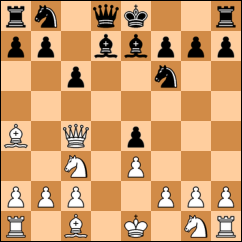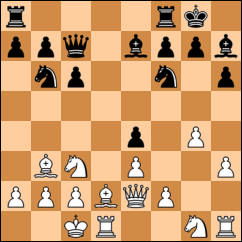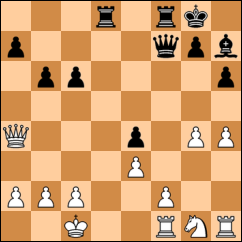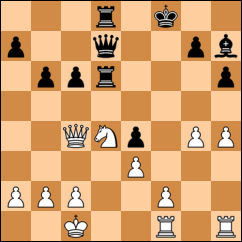Gary Sargent was kind enough to take notation in his game against Steve Black this week, giving me a respite from writing about myself.
S.Black–G.Sargent
Route 20 Chess Club
Freeport, Illinois, April 20, 2010
1.e3
A classic Steve Black "irregular opening."
1...e5 2.Nc3 d5
Chessbase points out that these first four moves were actually played in a game between Aron Nimzowitsch and Siegbert Tarrasch in 1928. Their game continued 3.d4 exd4 4.Qxd4 Nf6 5.e4 Nc6 6.Bb5 Bd7 7.Bxc6 Bxc6 8.e5 Ne4 9.Nxe4 dxe4 10.Ne2 Be7 11.Be3 Qxd4 12.Nxd4 Bd7 13.0-0 0-0 14.Rfe1 c5 15.Ne2 f5 16.exf6 gxf6 17.Nf4 Rf7 and after 18.Rad1 stood roughly even. Nimzo won after 66 moves.
3.Bb5+ c6 4.Ba4 Nf6 5.Qf3
This game, however, is not so well-balanced. Gary is steadily increasing his edge with each move.
5...e4 6.Qe2 Bd7 7.d3 Be7 8.dxe4 dxe4 9.Qc4??
Yikes! Steve walks into a pawn fork: 9...b5 10.Bxb5 cxb5 11.Nxb5 Nc6 wins a bishop for two pawns -- and development and space advantages that more than make up for the pawns. Luckily for him, Gary misses it.
10.Bb3 0-0 11.Bd2
Steve should be developing that king's knight.
11...Nbd7 12.0-0-0 Nb6
Weaker than it looks. It's time for a push for queenside space: 12...a5!? 13.Qf1 b5, giving black a decisive edge.
13.Qb2 Qc7
Gary said afterward that he thought he should have played Qc8 instead, but Fritz disagrees, favoring 13...Qc7 and a few other moves over 13...Qc8 -- but preferring 13...a5 14.a4 Nbd7 15.Ba2 Qc7 over all of them! The differences in evaluation, however, are minute: no more than one-fifth of a pawn's difference between 13...a5 and 13...Qc8.
14.h3 h6 15.g4 Bh7
This is where Gary starts to lose ground. The bishop needs to retreat to g6 (16.h4 Nfd7 17.g5) to maintain an edge.
16.h4 Nfd5 17.Rf1 Bb4
17...Nxc3!? might have forestalled the fireworks that are about to happen.
18.Nxd5 Bxd2+ 19.Qxd2 Nxd5 20.Bxd5 Rad8 21.Bxf7+ Qxf7 22.Qa5 b6 23.Qa4
It's a delicate balance. Black can maintain it with 23...Qd7.
23...Rd6 24.Ne2!
White's best move by far, bringing his last undeveloped piece out into the center. Steve has the advantage now.
24...Rfd8 25.Nd4 Qd7 26.Qc4+
Easily dodged. 26.Rhg1 straightforwardly defends the hanging g-pawn and leaves white's queen in place for a tradeoff in the event of ...c5.
26...Kf8??
Disastrous! Running out into the open leaves Gary's king in more danger than if it had simply cowered in the corner. His rooks and queen form a wall that the poor king is going to slam into.
27.f3!! Ke8 28.fxe4 Bxe4??
While Steve had a potentially winning advantage, he was only a pawn up materially, and Gary conceivably could have fought his way back. But this careless move invites checkmate. As Gary notes, "After satisfying myself that the check on f7 was livable, I missed that moving my bishop would allow a check on g8."
29.Qg8+! Ke7 30.Rf7# 1-0








0 comments:
Post a Comment